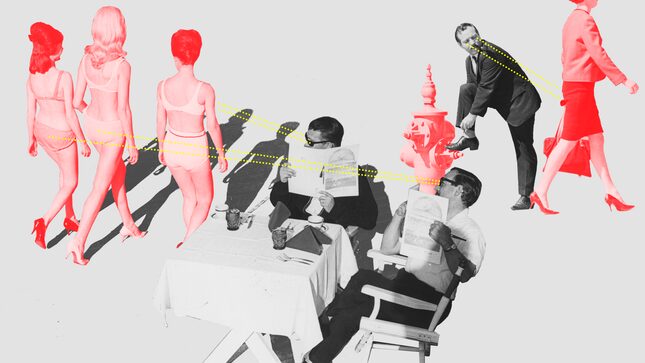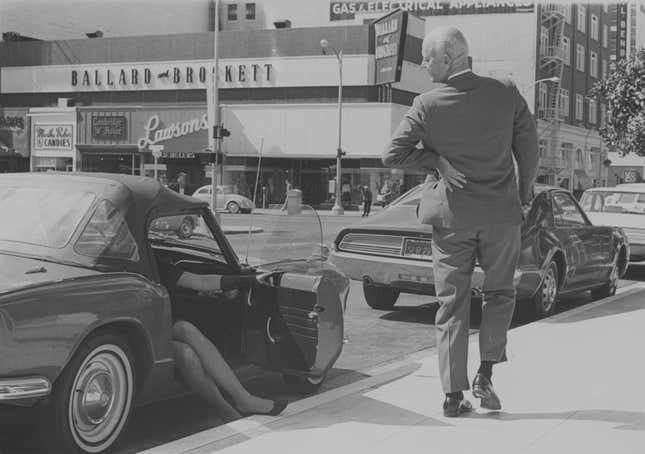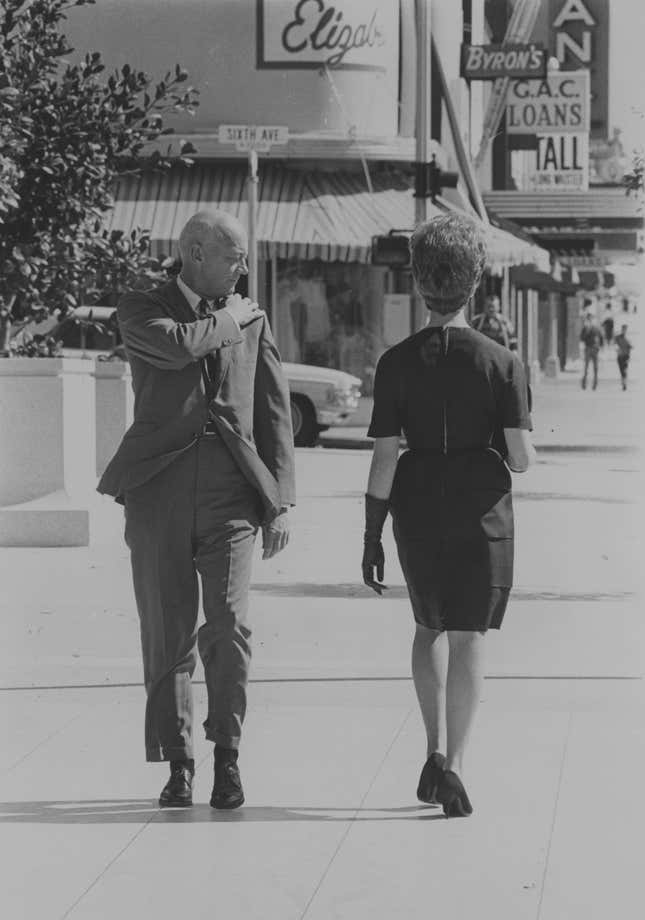
Graphic: Elena Scotti (Photos: Getty Images)
In the spring of 1968, 21-year-old Francine Gottfried began working as an IBM machine operator at a data processing plant in lower Manhattan. Gottfried walked past the New York Stock Exchange to get from the subway to work each day, and she soon attracted a group of Wall Street workers who gaped at her large breasts and verbally harassed her. Over the following months, men circulated the details of her daily schedule—she typically emerged from the Broad Street subway at 1:28 pm for her afternoon shift—and the crowd grew.
By September, Gottfried’s body and the men’s aggressive behavior had become national news: “Boom and Bust on Wall Street,” read one New York Magazine article. According to the Associated Press, the group of men stalkers reached more than 5,000 on a single day; another news outlet claimed the group hit a record of 10,000. Police became concerned about the rowdy crowds of men who clogged traffic and crumpled car roofs as they clambered for a better view of Gottfried’s breasts. Soon, Gottfried required a police escort and had to take new routes to work to avoid the street harassment.
But if Gottfried’s treatment seems horrific, she was just one of many women subjected to “girl watching,” a two-decade trend popularized by an ad executive and broadcast through major ad campaigns. Girl watching guides and girl watching clubs of the midcentury (alongside cartoons and advertisements) taught American men how to sexualize and harass women on the street, among other public places. These activities even had a soundtrack: At the very moment Gottfried was being harassed on Wall Street, the song “Girl Watcher” by the American pop band The O’Kaysions was climbing the charts. The history of this girl watching phenomenon speaks volumes about how the “male gaze” was made and then resisted.
In 1954, New York advertising executive Donald Sauers published a tongue-in-cheek book for “respectable” white men who liked to ogle women. Standing around and watching women had long been widespread, but earlier in the 20th century, middle and upper-class people considered the practice disreputable. A number of cities even tried to crack down on the “optical peccadillos” of men. In the 1920s in Montgomery, Alabama, the police chief announced that he would charge or arrest young men who stood on street corners ogling women and commenting on their appearances. A Baltimore police magistrate initiated a similar crackdown for men who cruised in cars and stared at women. And in Los Angeles in the 1930s, a city councilor introduced a bill that made it a crime for “two or more men, or boys 14 years of age or over, to ogle women in public spaces.” These authorities upheld the idea that girl watching was a low-class and unsavory practice.
Sauers, however, flipped the script. He claimed girl watching as a mainstream, middle-class activity, redefining it as a hobby that men should pursue with gusto. Loosely modeled on bird watching guides, The Girl Watcher’s Guide advised men on the best places to spot girls; it categorized women into different types, such as the “brown-backed beachbomb,” the “pubthrush” and the “fortyplus,” and it provided tips and tactics, especially for married men, on how to watch women discreetly. To promote the book, Sauers founded a girl watching club, the American Society of Girl Watchers, whose members received lapel pins and guidebooks. Tens of thousands of men joined Sauers’ group and similar clubs, and they purchased girl-watching books and magazines. Meanwhile, official girl watching weeks became popular across the United States and Canada.

The girl watching phenomenon gained steam in the 1950s at a moment when men openly embraced “picking up” women for casual sex before marriage. And a burgeoning erotica market, spearheaded by magazines like Playboy, Glamour Photography, and High Magazine appealed to the sexual fantasies of married men. The latter, High Magazine, surrounded features like “The Emasculation of the Suburban Male” and “Time Off For Husbands”—which advocated for vacations away from wives—with pictures of scantily clad women. Sauers’s girl watching guide, which taught married men how to discreetly look at women who weren’t their wives, hit the markets a year after the first issue of Playboy, which similarly advocated the casual sexual objectification of women. These publications all converged on the idea that married men’s gazes and fantasies extended well beyond the marriage bed.
Meanwhile, women who sought sexual intimacy outside of marriage or steady relationships were commonly called “sluts” or “pigs.” Non-lurid representations of unmarried women’s sexual desires were rare. There were notable exceptions including writer Helen Gurley Brown’s 1962 best-seller Sex and the Single Girl, in which she argued that women too should be able to experience sex for pleasure (and material gain) before marrying. But such claims took place within a culture that emphatically stated that sexuality was the prerogative of men. Within these contexts, the girl watching craze fostered the idea that even a passing encounter between a man and a woman in public offered men infinite visual pleasures and even sexual possibilities.
The Girl Watcher’s Guide didn’t become a 20-year fixture of American culture by itself: A series of ad campaigns by major brands like Pepsi and Pall Mall Cigarettes promoted girl watching. Sauers partnered with these companies for cross-promotional campaigns. For example, in 1967 Pepsi launched a national advertising campaign with Sauers’ help to promote Diet Pepsi as the drink for “girls that girl watchers watch.” Part of a strategy to reach young people, one promotion for Diet Pepsi offered students different buttons for men and women that celebrated their roles as watcher and watched. Men, the ad made clear, should enjoy women’s bodies, while women should watch their figures and invite men’s attention.
Pall Mall Cigarettes, meanwhile, ran advertisements nationwide promoting girl watching: “If the girl is watchable, she should be watched, no matter what her motives or ambitions may be,” proclaimed one. Not only did these cigarette advertisements offer “lessons” directly from Sauers’s book, but they also invited men to join The American Society of Girl Watchers. Countless Americans learned from these ads that “any male is eligible to become a girl watcher” and that any girl was meant to be and wanted to be watched. An ambitious girl, these advertisements reassured men, “really doesn’t want to compete with men. In her heart she wants to attract men and eventually marry one.” These advertisements also replicated the dehumanizing structure of Sauers’ book, which, like bird watching guides, categorized women (always referred to as “girls”) by various types (some more common than others) and body parts.
A 1969 syndicated news article that described girl watching as “America’s favorite outdoor sport” made this explicit. “Those who make an avocation of watching girls,” the article explained, “are divided into three classes depending on which portion of the feminine anatomy attracts their specialized interest—leg men, hip men, and bosom men.” Asked why there were no “face men,” a girl watching expert answered, “Why should there be? Any man whose head could be turned by a mere pretty face doesn’t deserve to be classed as a genuine girl watcher.”
Girl watching became a staple of mainstream and adult men’s magazines. In 1960, the men’s magazine True included a Girl Watchers’ Coloring Book which featured line-drawings of ample-breasted women posing seductively in public spaces. Soon Southern Comfort advertised its whiskey in the pages of Playboy magazine with a “Girl Watchers Drink Guide” that humorously compared women’s bodies to cocktails with puns about “all the correct measures” and “tall, slender shape[s].”
Sauers insisted that girl watching was a polite and genteel pastime for men: “A man with taste does not whistle at girls anymore. It is not considered sporting. He does not utter any sound which might betray his joy. In fact, any watcher of today who makes a passing remark or, heaven forbid, asks a girl for her phone number is no better than… than a bird watcher who steals eggs!”
But the lines between looking at, talking to and touching women were always thin. The San Diego-based International Society of Girl Watchers, which at one point claimed more than 10,000 members, encouraged men to interact with strange women they found attractive. Members received a rating card which they were supposed to fill out and hand to women they spotted. The card’s header declared, “You have been watched by a member of the International Society of Girl Watchers” and informed women how they ranked. Women could earn a number of categories including “Lovely, M-M-M, Refreshing, Smart, So So, O-o-la-la, not bad, exciting, feminine, mysterious, cold, could be.”

These rating cards encouraged men to feel entitled to look at, rate, and approach women to share their opinion of their looks. In some cases, members offered women “an additional complement” of a “watching eyeballs stick-on emblem” which stamped women as “watchable in the eyes of all society members.” The cards conveyed to men that women should be receptive to their gazes and evaluations and perhaps sexual propositions. They didn’t need to know these women—in fact, not knowing them was the point.
Such street encounters were not isolated. They were collective activities that were even endorsed by corporations, advertisers and politicians. In 1962, New York’s Freedomland Amusement Park held a nationally covered girl watching pageant, in which women competed for the title of “most watchable girl.” “Girl Watching Is An Organized Activity,” newspaper coverage of the event announced. An ABC TV game show host, Don Morrow, emceed the pageant. And the press noted that Morrow happily took up these duties, leaving his wife and their newborn daughter at home to do so. Don Sauers’ American Society of Girl Watchers helped publicize the event by declaring a National Girl Watching Week.
Men across the country eagerly took up the call to hold girl watching events. In 1964, a Cincinnati Enquirer article celebrated that city’s official Girl Watching Week, as declared by Republican Mayor Walton Bachrach. The article even included a “Girl Watchers’ Peep-Hole” with the instruction “Cut Along Dotted Line” so that men readers could surreptitiously watch women while reading about the phenomenon. Similar girl watching weeks were sponsored by the Chamber of Commerce in Culver City, California. And a group of businessmen declared a girl watching week in Atlantic City, home of the Miss America Pageant, in the early 1970s. They claimed that Atlantic City was the capital of “National Girl Watching Week,” and installed a 12-foot sign on the boardwalk.
Sauers’s brand of girl watching even took the international stage. In 1967, organizers of Montreal’s International and Universal Exposition, better known as Expo ’67, attracted visitors by claiming that the city boasted the world’s most beautiful women. They invited the American Society of Girl Watchers to set up a branch office in Montreal. Sauers’s group handed out rating cards to women they considered “most watchable.” The Montreal press played up the publicity stunt. An article in the Montreal Star read: “Attention all girl-watchers: shift base of operation to Expo ’67 immediately….Fifteen hundred ‘girls who have everything’—beauty, charm, gorgeous proportions and intelligence—are hostesses for the six-month event.” Such advocacy of urban girl watching jovially took for granted that it was men’s prerogative to sexualize women and to openly enjoy how they looked.
Francine Gottfried’s experience showed just how bad it could get. Her 15-frightening-minutes-of-fame did not end with police dispersing Wall Street crowds—in fact, the street harassment quickly became a commercial enterprise. Adult magazines and club promoters offered her large sums to pose nude or dance topless. One entrepreneur approached her with lucrative offers to simply stand outside his club to attract customers. Although Gottfried rejected these proposals, other busty women sought to spark a media frenzy and men’s gazes for profit and attention. The AP reported how radio stations flew large-chested women to New York City to have them parade down Wall Street and “compete” with Francine Gottfried. The event was billed as the “battle of the Bulge on Wall Street.” KGIL sponsored 36-year-old Geri Stotts of Burbank “who measures 47-29-38,” and Cleveland radio station WIXY flew in Sheila Moore and Suzanne Zulkowski “to show New Yorkers that the Ohio city could match the 43-25-37” of Gottfried.
In the late 1960s and early 1970s, feminist activists organized public protests to contest and reverse the demeaning power dynamics inherent in the girl watching phenomenon. These took place in a number of cities including Boston, East Lansing, Los Angeles, and New York. In 1970, partly in response to Gottfried’s harassment, lesbian feminist Karla Jay led other women’s liberationists in organizing their own “ogle-in” on Wall Street. They wolf-whistled at men on the street and loudly appraised their physical attributes. Feminist activists in Los Angeles soon organized similar boy watching events to challenge an official girl watching week endorsed by a local Chamber of Commerce. With tape measures in hand, they pretended to take men’s measurements on the street and mocked men they encountered by shouting “too small!”
As Susan Brownmiller, author of the best-selling Against Our Will: Men, Women, and Rape, wrote of this event in her 1999 memoir: “A bunch of us would gather on a street corner and turn the tables on leering, lip-smacking men by giving them a taste of their own medicine.” Feminist activists showed men what it felt like to be on the receiving end of such unwanted sexual attention—that being constantly leered at was threatening. They felt unsafe in public and worried, based on numerous shared experiences, that leering could quickly turn into sexual assault. In 1968, on a public radio show, feminists complained about girl watchers but warned each other not to talk back to these men unless they were in groups or were prepared to run, lest they face violence.The phrase “girl watching” has largely disappeared but the practice of girl watching continues, albeit in new forms and under different names. Men still stare at and comment on women’s bodies in public. But girl watchers no longer wield the cultural power and impunity they once did. Inspired by decades of feminist activism, women increasingly look back, talk back, and “hollaback,” contesting a male gaze. Surely, Don Sauers would be disappointed.
Gillian Frank is co-host of the “Sexing History” podcast and a postdoctoral research fellow at University of Virginia’s Program in American Studies.
Lauren Gutterman is co-host of the “Sexing History” podcast and an assistant professor of American Studies at the University of Texas at Austin.
Subscribe to their podcast, Sexing History, on iTunes. For more on the history of girl watching and pick up artists, check out this episode.